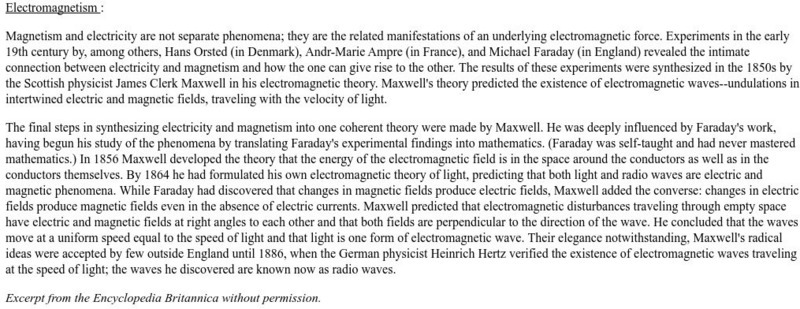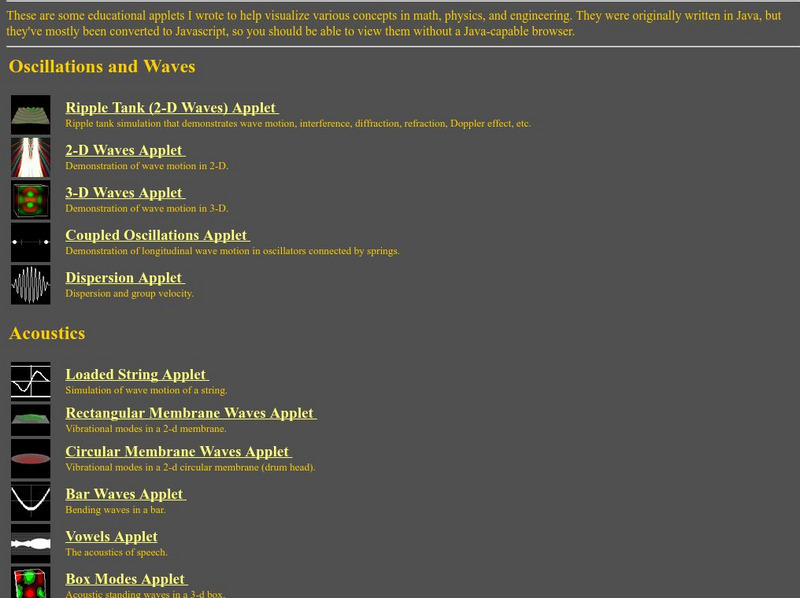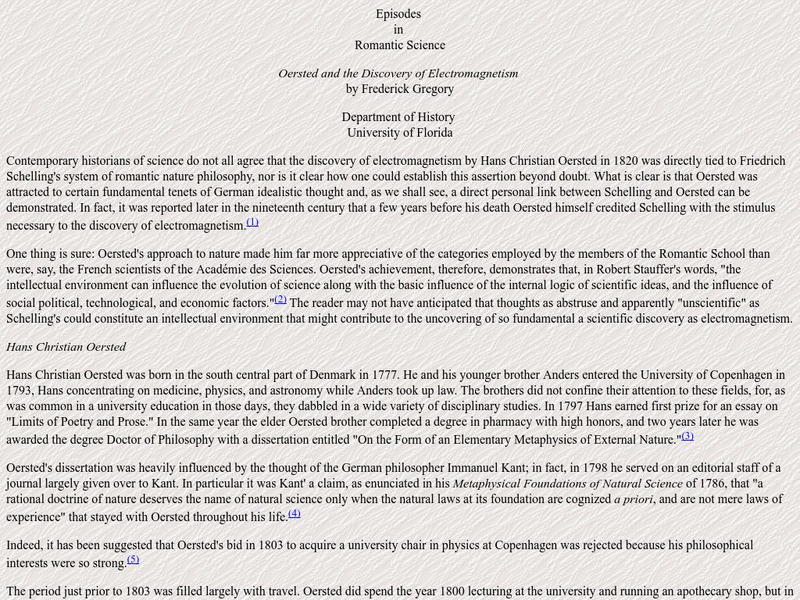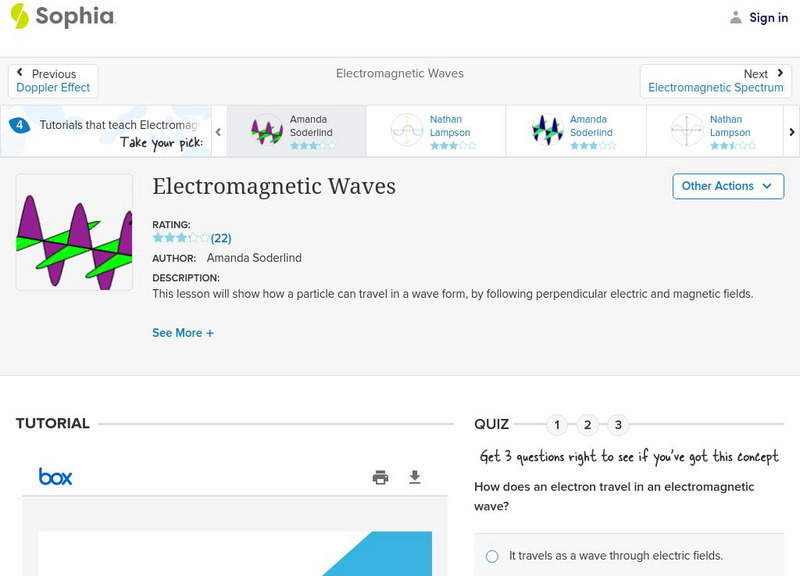Science Bob Pflugfelder
Science Bob: Build an Electromagnet!
This site presents a procedure for creating your own electromagnet using an iron nail, some wire, and a battery. The site illustrates a connection between electricity and magnetism.
National High Magnetic Field Laboratory
Magnet Academy: Arc Lamp 1876
Fire lighted the night for many centuries. Then came Sir Humphry Davy and the birth of the arc lamp, an invention built upon in the years that followed by many.
University of Oregon
University of Oregon: Electromagnetism
A solid summary from the University of Oregon of the work of James Maxwell Clerk, Michael Faraday, and others in the field of electric and magnetic phenomena. This is a fine essay.
National High Magnetic Field Laboratory
Magnet Academy: Bubble Chamber 1952
To understand a bubble chamber, picture the long, white streak an airplane leaves in its wake. That's water vapor produced by condensation from the plane's hot exhaust. Until the water particles evaporate, you can follow the streak to...
National High Magnetic Field Laboratory
Magnet Academy: Cyclotron 1931
A cyclotron is a machine that allows scientists to shoot particle beams at other particle beams. The result of doing this is a spectacular smash up - but that's not why scientists do it.
National High Magnetic Field Laboratory
Magnet Academy: Coaxial Cable 1929
As more and more American households acquired telephones, the pressure was on to create a better cable to accommodate the increasing demand. Engineers Lloyd Espenschied and Herman Affel answered the call.
National High Magnetic Field Laboratory
Magnet Academy: Audion 1906
Two years after Englishman John Ambrose Fleming invented a two-electrode vacuum tube, American inventor Lee De Forest one-upped him by developing a tube with three electrodes.
National High Magnetic Field Laboratory
Magnet Academy: Gauss Weber Telegraph 1833
Several years before the telegraph created by American inventor Samuel Morse revolutionized communications, two German scientists built their own functional telegraph.
National High Magnetic Field Laboratory
Magnet Academy: Gramme Dynamo 1871
Zenobe Theophile Gramme (1826 - 1901) invented the first industrial generator, or dynamo. A deceptively simple-looking machine, it consisted of 30 coils wrapped around a spinning ring of iron.
National High Magnetic Field Laboratory
Magnet Academy: Bell Telephone 1876
Acoustics, variable resistance and allegations of foul play contribute to the exciting story of the invention of the telephone.
Mocomi & Anibrain Digital Technologies
Mocomi: What Is Electromagnetism?
Explains electromagnetism, the difference between a permanent magnet and an electromagnet, uses of electromagnetism, and steps for making a simple electromagnet.
Curated OER
Ultra Simple Electric Generator
All the components are here for you to build an electric generator. Parts list, construction, testing, how it works, feel the electrons, and more.
Curated OER
Physics4 kids.com: Electricity & Magnetism: Resistance
Simple line graph showing the inverse relationship between the amount of electrical resistance and the amount of work possible.
Vision Learning
Visionlearning: Physics: Light Ii: Electromagnetism
Instructional module focusing on light and electromagnetism. Discussion includes historical discoveries that led to the understanding of the electromagnetic spectrum. Site also includes an interactive practice quiz and links relating to...
University of St. Andrews (UK)
University of St. Andrews: Charles Augustin De Coulomb
A large complete authoritative biography of Coulomb. Five large pictures, over a dozen links to contemporaries, references, a poster, other mathematicians. A fine source.
Other
Math, Physics and Engineering Applets
Written by Paul Falstad, these educational Java applets address myriad concepts related to electrostatics, magnetostatics and electrodynamics. You'll find instructions on how to operate each applet, but little explanatory material.
OpenSciEd
Open Sci Ed: 8.3 Forces at a Distance
This unit allows students to investigate the cause of a speaker's vibration in addition to the effect.
University of Florida
University of Florida: Episodes in Romantic Science
One of the "Episodes in Romantic Science," this is as complete as a biography gets without being a book. Includes great information about Oersted and his electromagnetic work, The definitive source. Heavily footnoted with many additional...
Cuemath
Cuemath: Vectors
Explore the world of vectors, by finding answers to questions like what are vectors, what are scalars, what is the difference between scalar and vectors, the magnitude of a vector, operations on vectors, and properties of a vector.
TeachEngineering
Teach Engineering: Yogurt Cup Speakers
This lesson introduces students to the role of electricity and magnetism as they build a speaker. In addition, students explore properties of magnets, create an electromagnet, and determine the direction of a magnetic filed. They conduct...
Massachusetts Institute of Technology
Mit: Open Course Ware: Supplemental Resources: Continuum Electromechanics
College-level electrical engineering and computer science textbook highlighting the applications of continuum electromechanics.
Sophia Learning
Sophia: Electromagnetic Waves: Lesson 1
This lesson will show how a particle can travel in a wave form, by following perpendicular electric and magnetic fields. It is 1 of 4 in the series titled "Electromagnetic Waves."
Physics Aviary
Physics Aviary: Thomson's Cathode Ray Tube Lab
This lab is designed to have students look at the deflection of a cathode ray beam using magnetic fields and electric fields.
Science Education Resource Center at Carleton College
Serc: Electromagnetic Induction Demonstration
Students learn the relationship between the electric and magnetic fields. Specifically, they verify that a magnetic field is created in a current carrying coil of wire and a changing magnetic field can induce a current in another coil of...



















